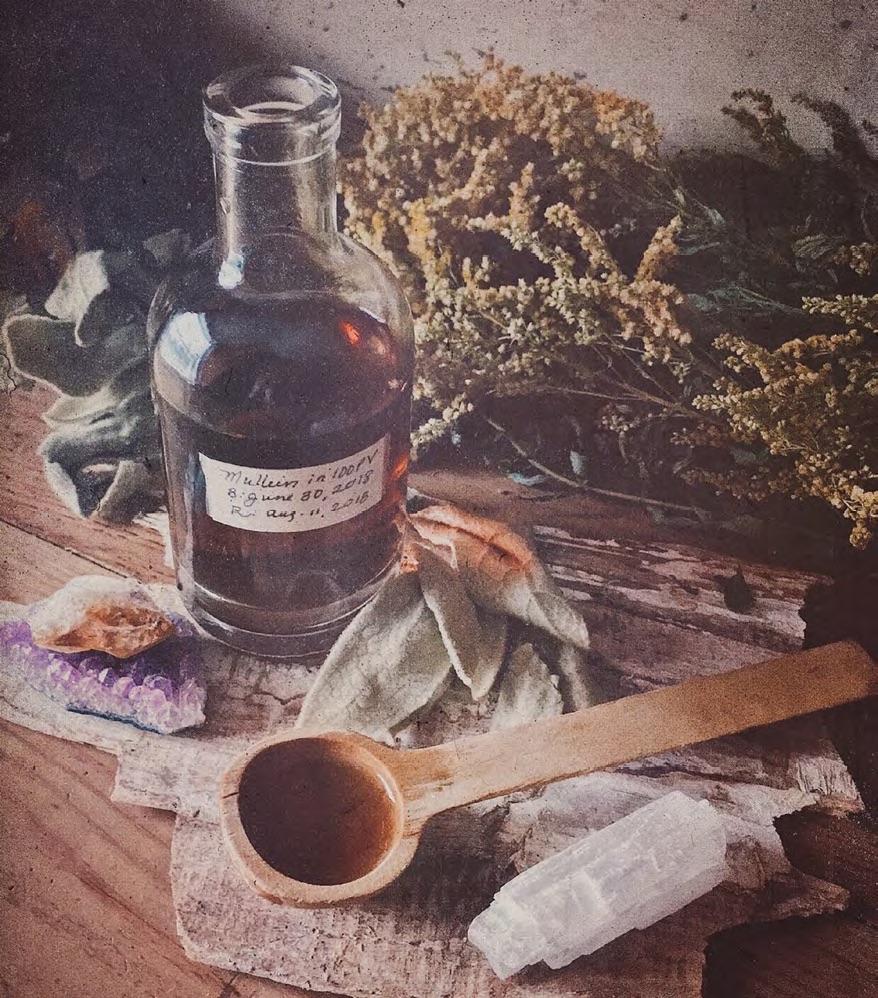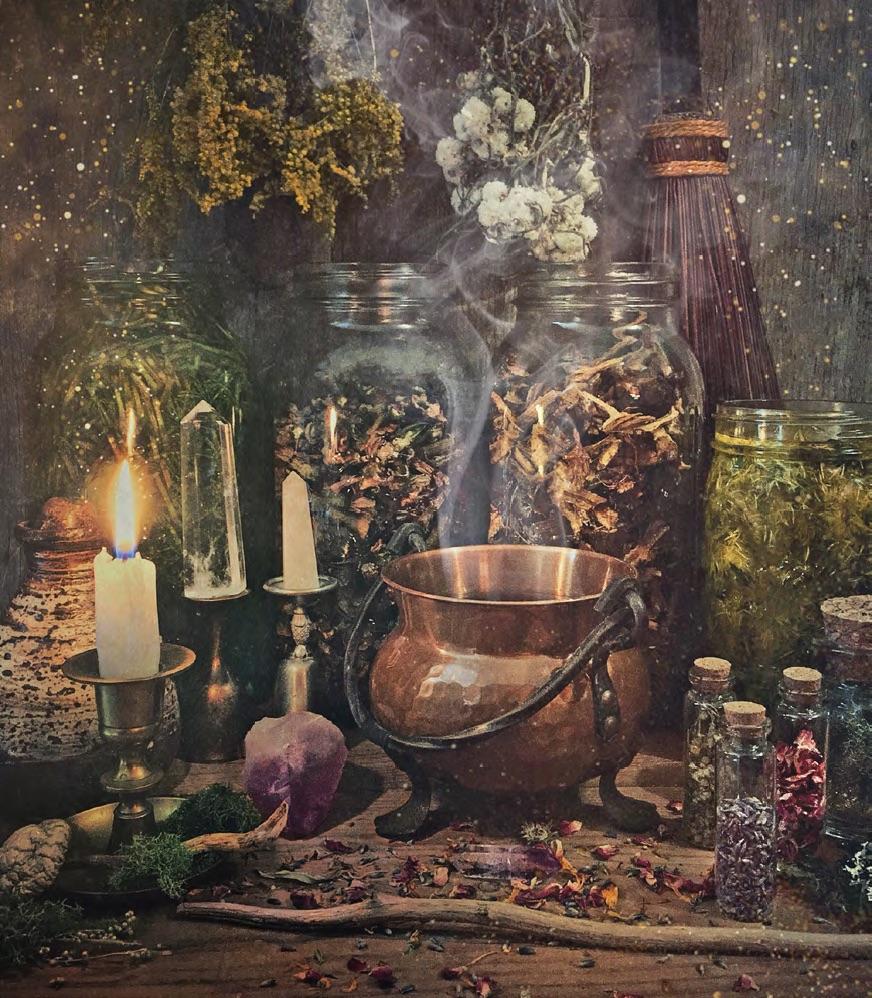 Enchanted Living: Can you tell us a bit about yourself?
Enchanted Living: Can you tell us a bit about yourself?
Susan Tuttle: Hi there from the woods of Maine! I’m a mama, folk herbalist, photo artist, and natural witch with “green” and “hedge” propensities. I run a small home-based online business, In the Wood Botanicals, offering wildcrafted, plant-based body and soul-care products made from simple plant allies I reverently and responsibly forage from the woods, fields, and riverside that surround our home.
EL: How do you define a hedge witch and in what ways have you identified as one?
ST: In my heart, I know I’ve been a witch for a very long time, in this lifetime and in past ones. One of the things that’s exciting about being a witch in today’s modern world is that there are numerous ways to be one, and no two witches will ever be the same. I’m not necessarily a fan of labels, as they can be confining and sometimes used with harmful intent, but they can also be useful and helpful when it comes to conveying and sharing information. I identify as an eclectic, natural witch. I embody both “green” witch and “hedge” witch qualities. The “green” part of me feels deeply connected to Mama Earth, co-creates with healing plants to make medicine and food, gardens, and is connected to the fae spirit entities of the land that surrounds my home in the Maine woods. The “hedge” witch in me has one foot in the earthly plane, and the other across the hedge, in the Otherworld. As a hedge witch, I practice divination (mostly via scrying and tarot), engage in spirit communication, and practice the art of hedge riding, which in essence is taking
a meditative journey to the Otherworld to gain knowledge, wisdom, and ultimately to strengthen and better oneself for the sake of being of service to the planet and others.

EL: Can you tell us about how you forage for the plants you use?
ST: I feel very fortunate to live in a natural landscape that affords me the privilege of foraging for numerous plant allies and fungi, for the purposes of making “medicine” and meals. I forage from early spring until just after the first fall frosts. My dear friend made me the most beautiful foraging basket, which I take out into the forest with me, along with tools of the trade. The whole experience is very spiritual for me. I walk slowly, do a lot of observing and listening, feel loving energies swirling all around that are so easy to lose the ego in and feel a part of, and get called in certain directions (butterflies often appear and lead me to certain plants, or sometimes I literally feel like I am being taken by the hand and led). Before I harvest a plant, I touch it, communicate with it, speak my intentions of what I plan to do with the plant, I ask permission before harvesting a small amount (only what I need), and I thank the plant. I co-create with burdock, jewelweed, violets, plantain, sweetfern, mullein, comfrey, mugwort, linden, purple loosestrife, evergreens, birch, medicinal and edible mushrooms, wild primrose, dandelion, goldenrod, smartweed, pearly everlasting, self heal, yarrow, nettle, St. John’s Wort, and more.
EL: Do you have a particularly strong affinity for certain plants?
ST: I do, and this shifts, depending on which plants are needed in that particular point in time (I may not even consciously know they are needed yet, but I follow my instinct and trust in the plants that are presenting themselves in a strong way). For instance, I harvested and processed an abundance of Japanese knotweed this year, making a tincture that turned out to be necessary medicine for my dear friend’s child who later contracted Lyme disease. I have a strong affinity for dandelion, which grows rampant in our yard. If people knew how many amazing things this plant can gift us with (both medicine and food- and drink-wise), they would not treat her as a pest to be eradicated. St. John’s Wort, another favorite, is a key ingredient in a pain salve that I make, which has helped bring relief to myself, my family and friends, and so many who have purchased the salve from my shop. Goldenrod is another one. She goes into my wildcrafted fire cider, which keeps me and my family healthy throughout the cold Maine winter. And mugwort, which I use for divination purposes (Note: Pregnant women should not use mugwort).

EL: When did you first come to realize the healing properties of plants? Did you grow up with this knowledge?
ST: I grew up in the woods and spent the majority of my time alone, exploring them. This fostered a deep relationship between myself and the plants and animals I lived with. Even when I moved to Boston in my twenties, I remained drawn to the natural world and tried my best to incorporate it into my life. I did eventually return to the woods, to settle down and start a family, and have lived here for twenty years. It’s the place where I feel most at home. I made it a point to be able to identify and know the plants and trees on the land here—if they are native or not, medicinal, edible, poisonous. I have a voracious appetite for learning about them, and the more I learn, the more there is to learn. It’s written in our DNA to be connected to the land. It’s within us, and each and every one of us can connect or reconnect if we choose it.
EL: When did you open your online apothecary?
ST: In early spring of 2019. It was a natural outgrowth of what I was already doing—making medicine for family and friends that really works and supports health and vitality. I made more of what I already make, to share with others in the online apothecary. It’s a way I can be of service.
EL: Do you have advice for our readers who want to learn more about wildcrafting and herbalism?
ST: Yes, do it! I recommend taking local foraging and herbalism classes in your area. There are amazing authors out there too. Herbalism luminaries like Rosemary Gladstar, Robin Rose Bennett, Deb Soule, and Susun Weed. Foraging and wildcrafting experts Leda Meredith, David Spahr (I’m fortunate to have him as a personal teacher here in Maine), and Pascal Baudar. On Instagram, I recommend following April Graham @she_is_of_ the_woods, as she shares a plethora of knowledge and upholds an important philosophy of “No knowledge held hostage for profit.” I readily share on my Instagram feed as well, in both my posts and on my IGTV channel.

EL: How do you stay enchanted in your daily life?
ST: There are so many ways to do this, and it does not have to be elaborate. Magic can be found in the everyday, simple experiences. For me, living in the woods and working with amazing healing, magical plants all the year round does it—harvesting and making infused oils, tinctures, and tea blends in the warmer months, and crafting body-care products with them in the winter. I also stay inspired by making witchy, magical art almost each and every day.
EL: Are there any simple remedies you’d like to share?
ST: Sure! Before I do, I want to mention that I regularly share all kinds of herbalism and witchcraft information, tips, and recipes on my Instagram. Here’s a simple recipe that’s yummy and medicinal
Visit Susan Tuttle’s online shop at inthewoodbotanicals.com, and find her on Instagram and IGTV @whisper_in_the_wood.
HERB-INFUSED MEDICINAL HONEY
In addition to being a sweet and luxurious natural treat, honey offers potent medicine. When infused with medicinal herbs, its healing potential soars. Herbal honey is easy to make, has a variety of uses, a long shelf life, and is the perfect way to capture the taste of summer to be enjoyed on a cold winter’s day.
One of my favorite herbal honeys to make is peppermint-infused raw, local wildflower honey, crafted with fresh peppermint sprigs from my garden. It tastes like a candy cane and I enjoy eating it by the spoonful throughout the year. It’s delightful in tea and makes a wonderful cough and cold remedy. It soothes sore throats, helps clear a stuffy nose, is antibacterial, anti-viral and anti-inflammatory, supports the digestive system, calms an upset tummy, and curtails nausea.
I simply fill a jar ⅔ full with fresh herb (⅓ full if dry), pour honey over it, filling the jar. Cap it and set it in a warm and sunny window for a period of two weeks. Strain and enjoy!
So many herbs can be infused into honey. Here are some I enjoy using: bee balm, tulsi, lavender, rose petals, lemon balm, linden, rosehips, rosemary, thyme, sage, and violet.


































